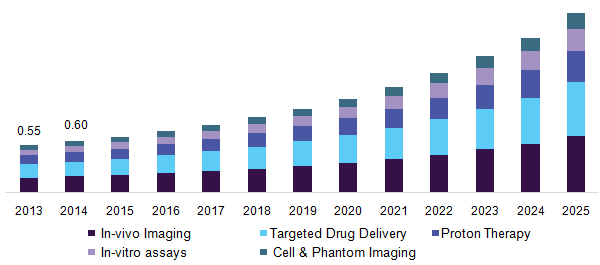The global nanoparticles — metal & metal oxides market in healthcare is anticipated to reach USD 80.74 billion by 2025, according to a new report by Grand View Research, Inc. Several nanotechnologies based medicines have been put forward for approval by the FDA which is anticipated to propel growth.
Success of nanomedicine has prompted the development of enhanced nanomaterials for clinical applications with particular emphasis in therapy and diagnostics. This has resulted into the significant production of metal oxide particles that hold potential utility in human medicine.
Remarkable evolution has been made in nanoparticle based medicines for theranostic applications in disease management. Diverse metals have been used for development of medicines with a promise to optimize the efficacy of nanomedicines and to improve the current standard of medical and clinical practices.
These particles are recognized to have major applications in drug delivery, diagnostic products, biomarker discovery, and product packaging. Widespread application spectrum of these particles in maintaining human health is expected to dramatically impact the progress of this market in the coming years.
Moreover, metal oxides are observed to have significant role in cancer treatment. Nanoparticle-augmented systems enable high-concentration targeted drug delivery to cancer cells, which in turn, is expected to enhance the usage rate of metal nanoparticles for cancer treatment. Development of drug delivery strategies using nanoparticle approaches are expected to bring about changes effective for cancer treatment.
However, prolonged exposure of nanoparticles adversely affects the human health as well environment thereby restraining their adoption rate. These products are involved in autophagy, oxidative stress, lysosome dysfunction, and the activation of certain signaling pathways, thereby exhibiting toxicity for human health.

Further key findings from the report suggest:
- Presence of untapped potential in alumina and alumina oxide particles is anticipated to create immense opportunities
- Aluminum oxide in combination with polymeric membranes is studied for enhancement of drug delivery owing to its high porosity property displayed in the membranes
- This enhanced efficacy of the membrane performance by the addition of alumina nanoparticles to polymeric membranes is projected to increase its adoption
- Approval of various nanoparticle composition and surface properties for clinical diagnostics and treatment of viral infections is anticipated drive market demand
- In-vivo imaging dominated the market with respect to revenue share
- Use of antibody conjugated to Au nanorods Raman spectrum with polarized, sharpened, and enhanced results can be attributed for larger revenue share
- Oncology dominated over a decade and is projected to sustain its share over the forecast period.
- Rising incidence of cancer and other chronic multi-drug resistant diseases pronounces the demand for these particles.
- Aforementioned factor is anticipated to drive targeted delivery with fastest YoY growth
- Asia Pacific is projected to showcase lucrative progress in the coming years
- Key countries in the region are working to enhance the patient’s reach to nanotechnology-based solutions
- Moreover, continuous support from the government bodies pertaining to initiation of new projects is expected to play crucial role for projected CAGR
- Key players contributing in this market are Pfizer Inc., Brigham Women’s Hospital (BWH), Immunolight LLC, nanoComposix, Nanobiotix, Nanospectra Biosciences, Inc, Merck KGaA, and AstraZeneca
- These participants are investing in development of the product portfolio that can target the chronic disorders
- Arrowhead Pharmaceuticals, Cytimmune Sciences, Inc, Nanobiotix, Celgene Corporation, Siteman Center of Cancer Nanotechnology Excellence (Washington University CCNE), and BIND Biosciences are few companies that have products in the pipeline phase